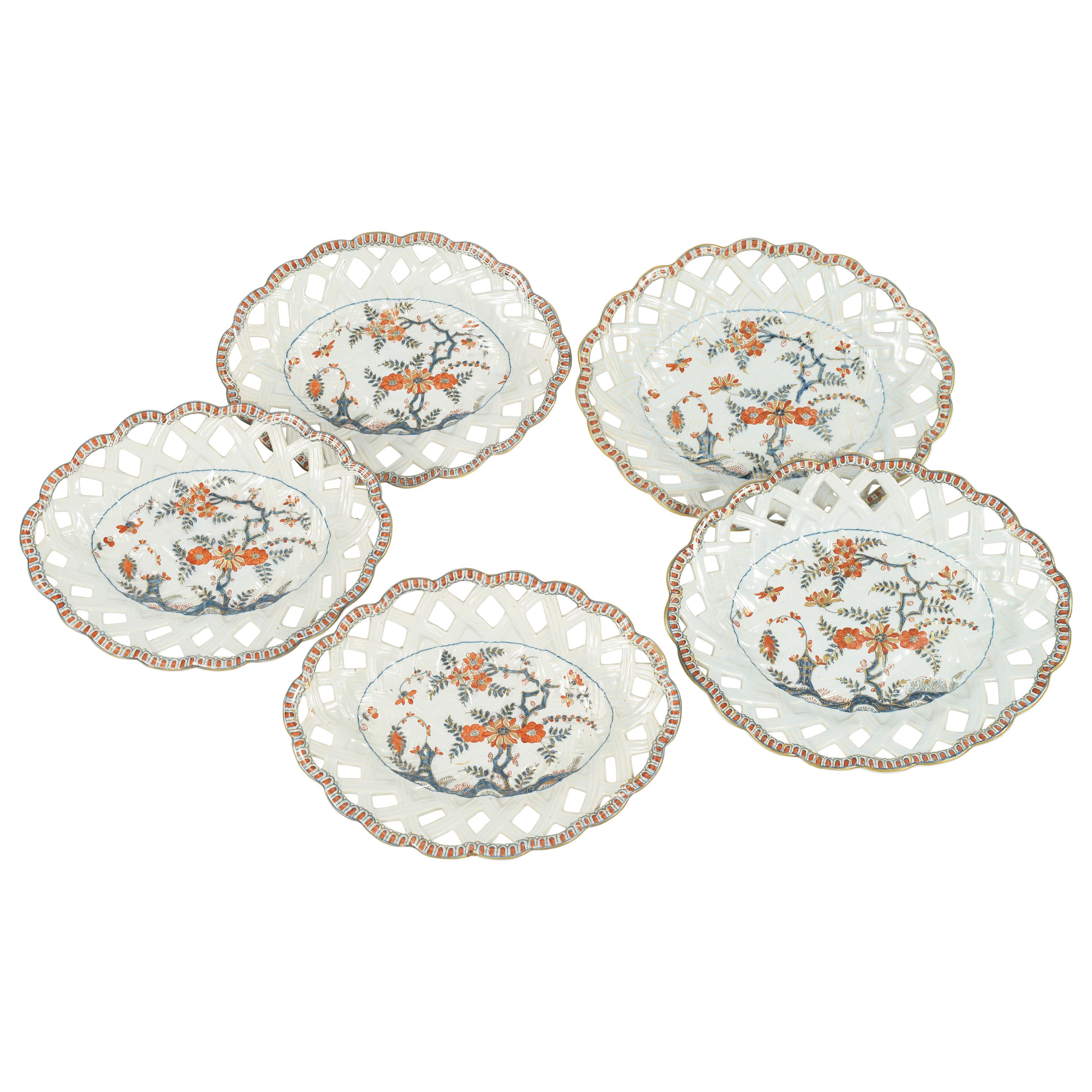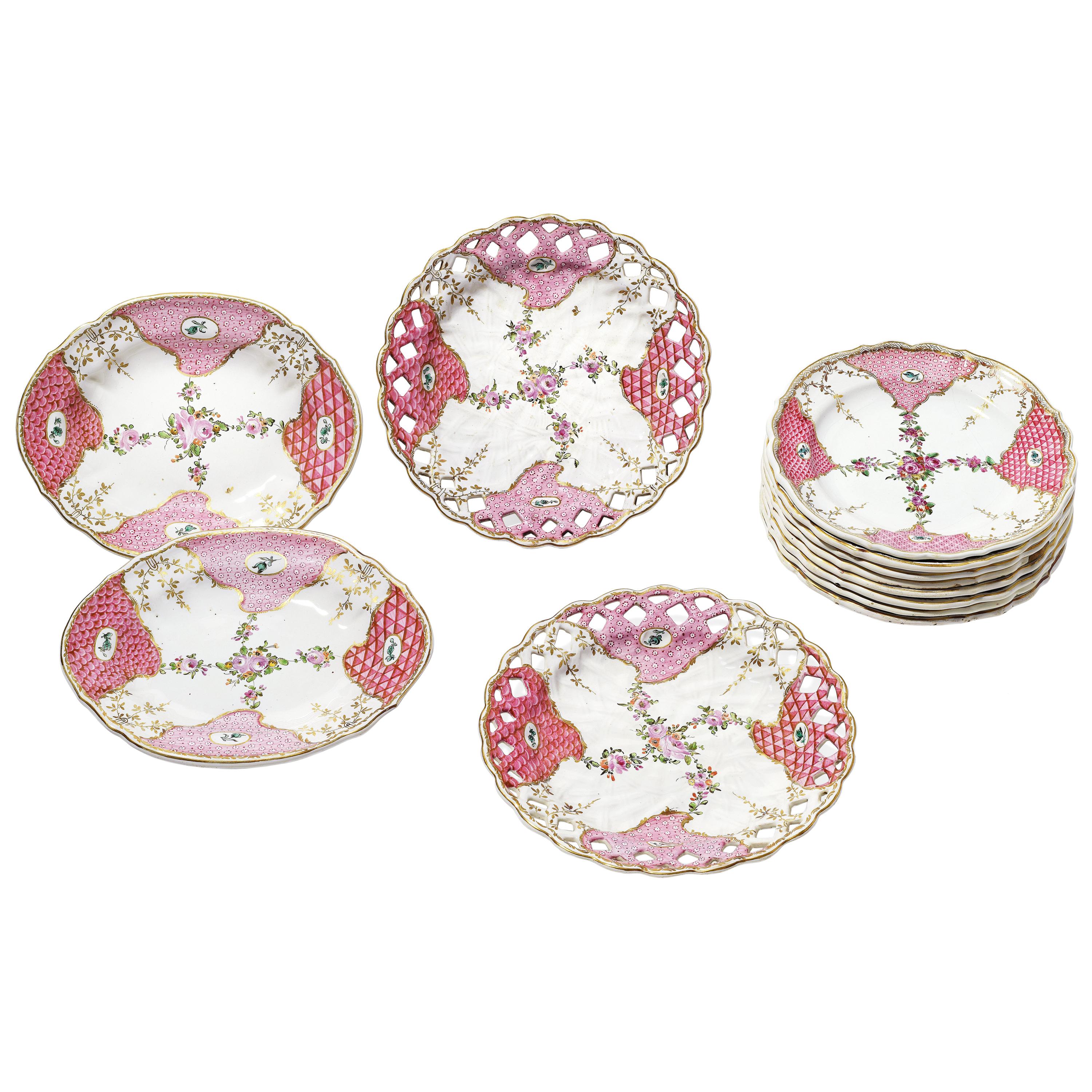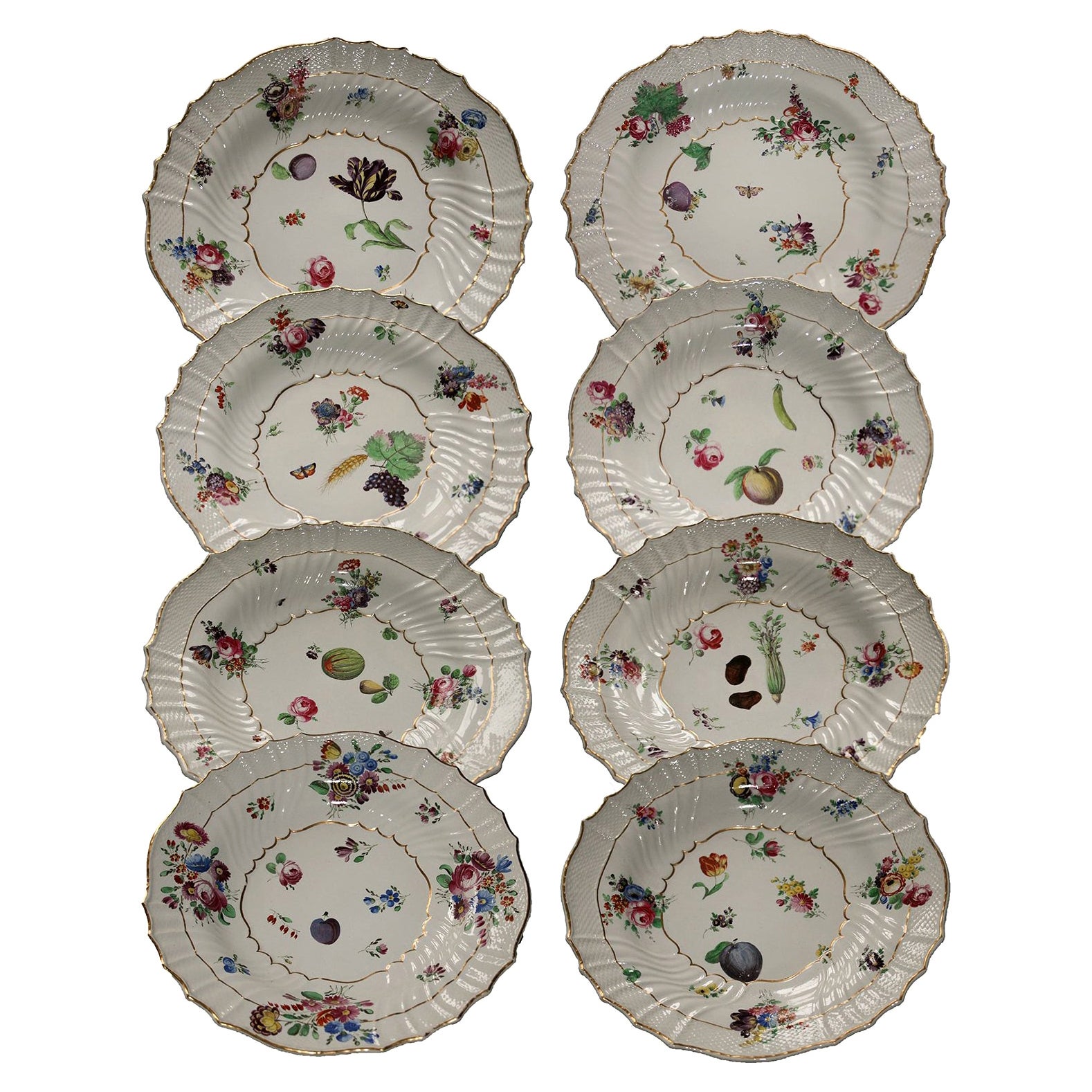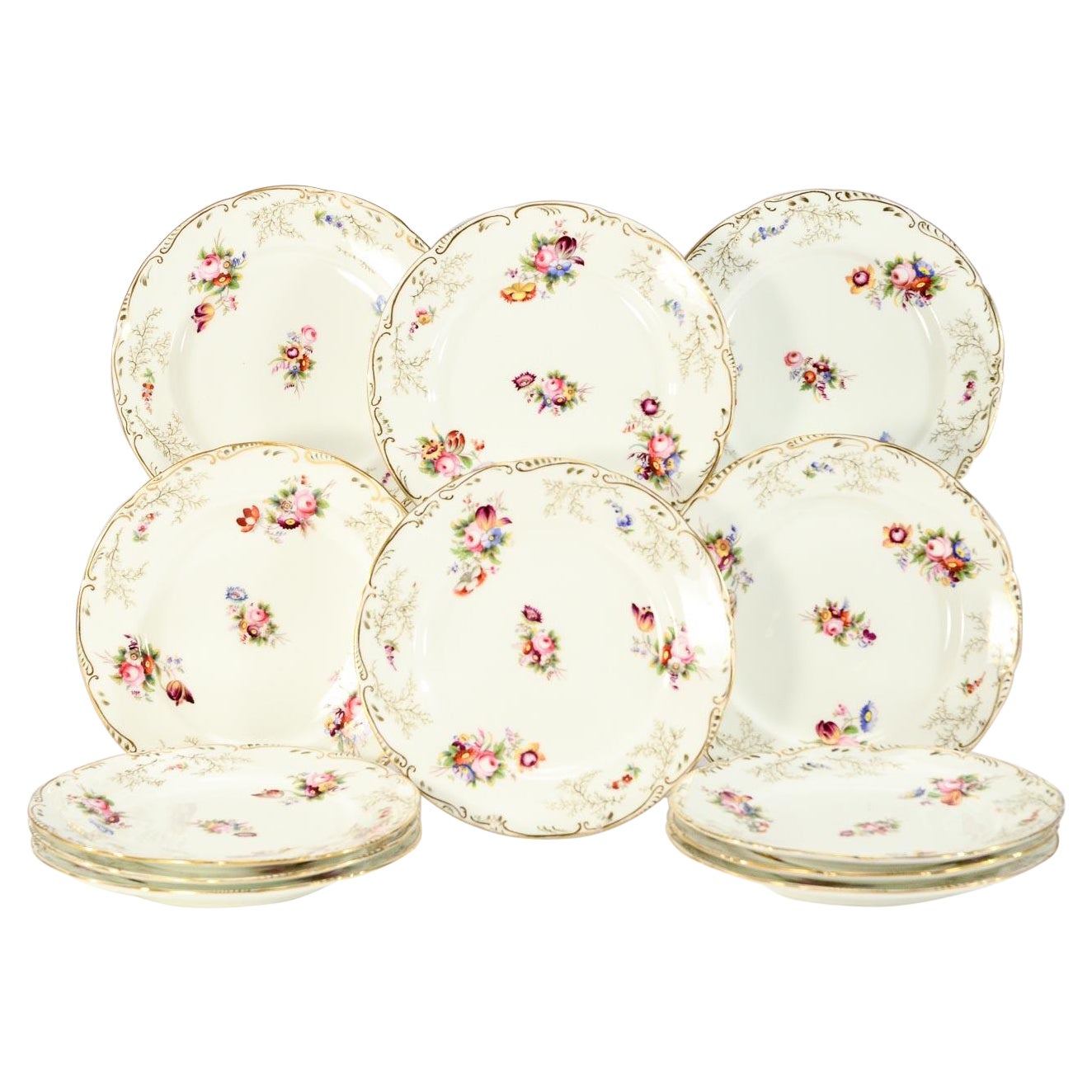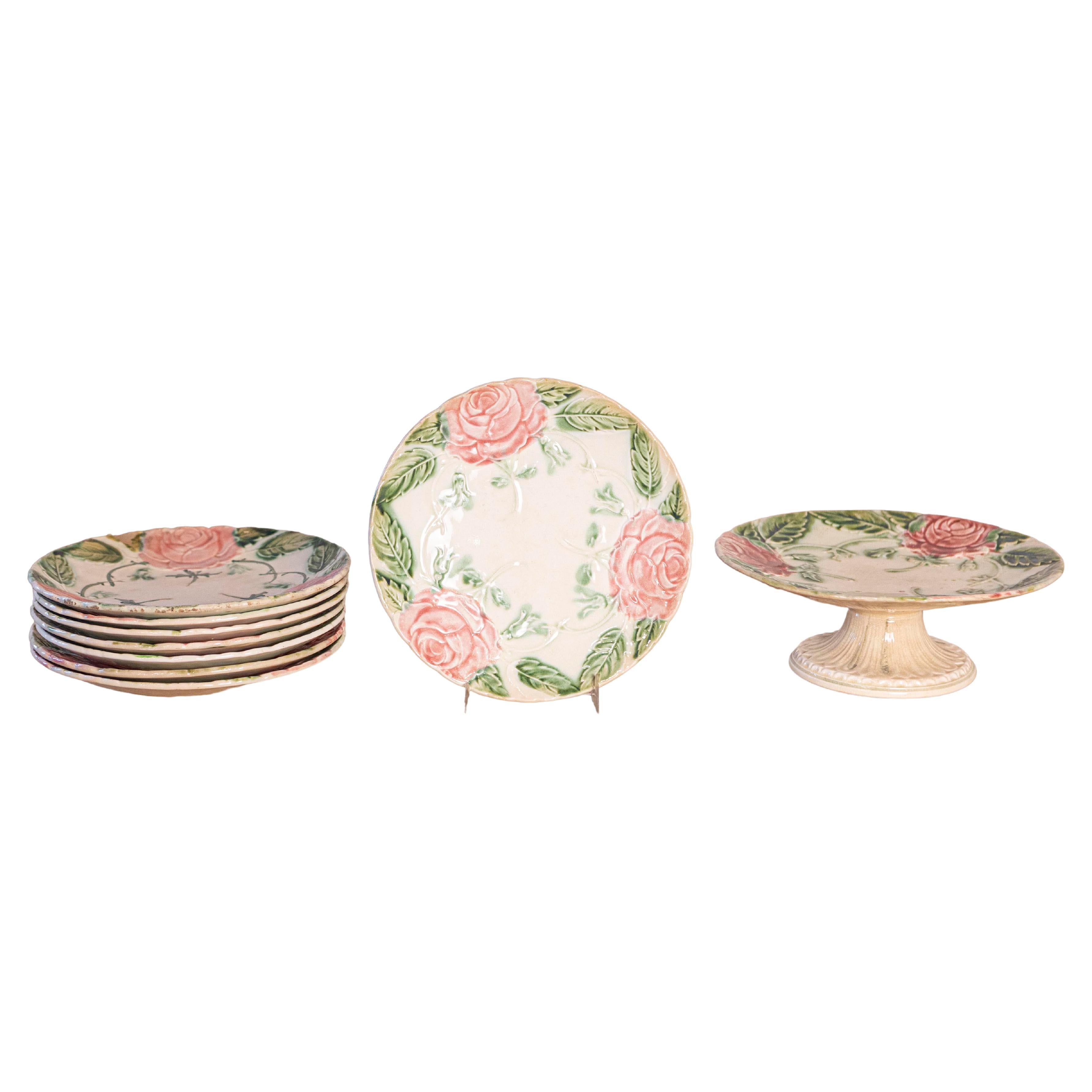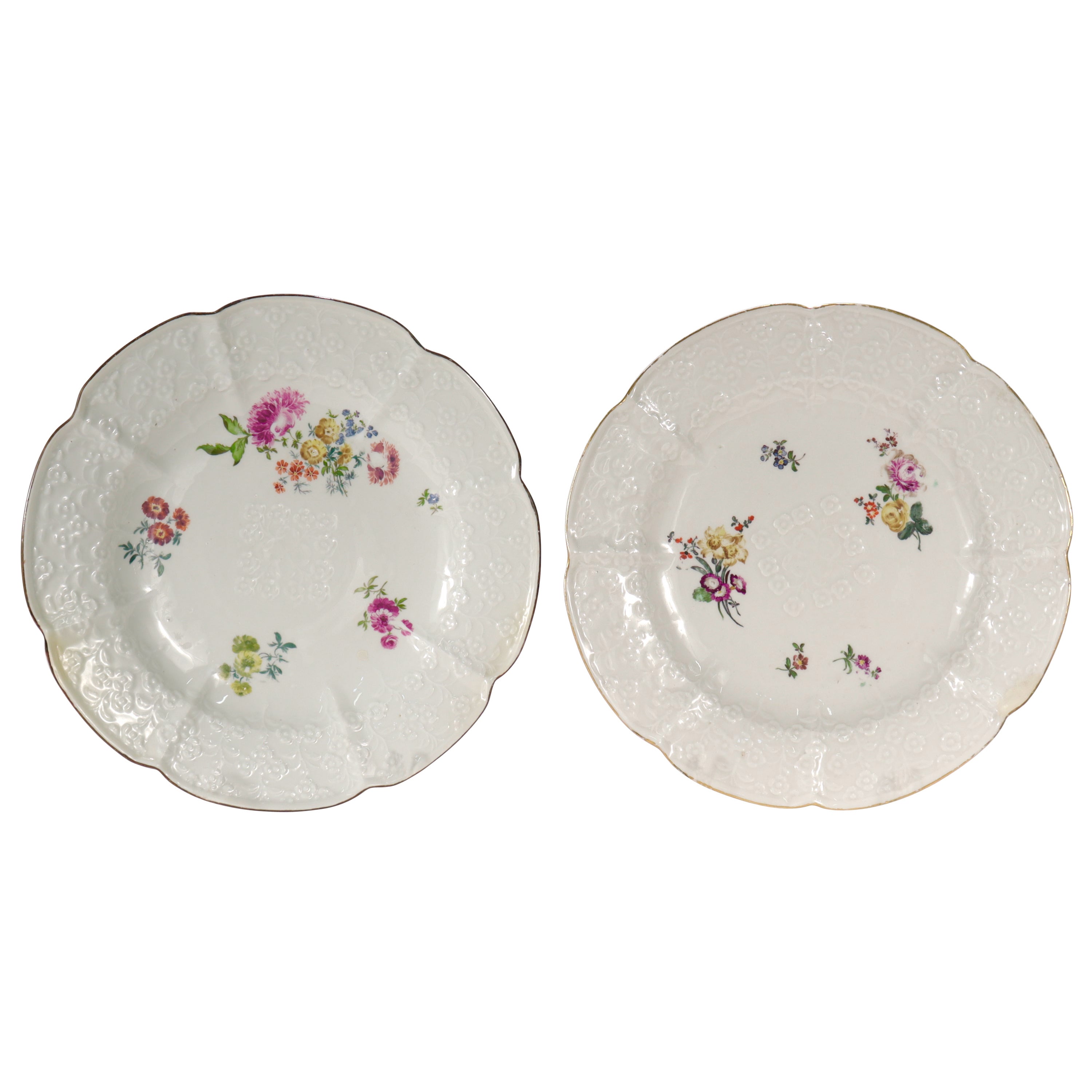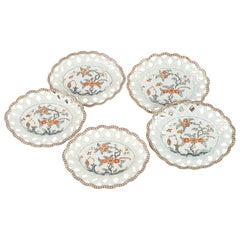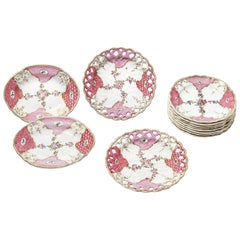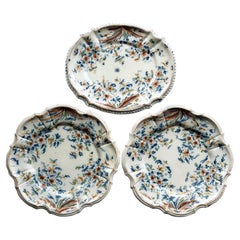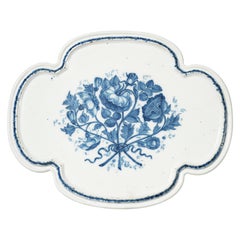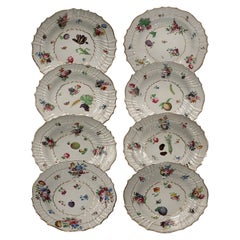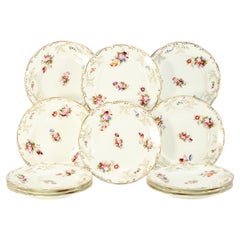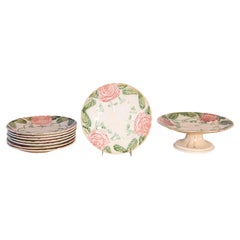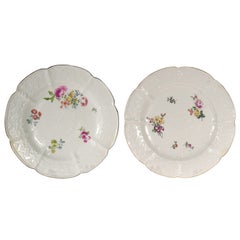Items Similar to Ancient Maiolica Dishes with flowers, Lombard Manufacture, 1770-1780 Circa
Video Loading
Want more images or videos?
Request additional images or videos from the seller
1 of 19
Ancient Maiolica Dishes with flowers, Lombard Manufacture, 1770-1780 Circa
$5,396.31per set
£4,014.31per set
€4,500per set
CA$7,389.39per set
A$8,215.99per set
CHF 4,289.94per set
MX$100,008.64per set
NOK 54,737.74per set
SEK 51,286.65per set
DKK 34,256.01per set
Shipping
Retrieving quote...The 1stDibs Promise:
Authenticity Guarantee,
Money-Back Guarantee,
24-Hour Cancellation
About the Item
Assortment of dishes
Lombard manufacture
1770 – 1780 Circa
Maiolica polychrome decorated “a piccolo fuoco” (third fire).
Two large dishes: diameter 14.76 in (37.5 cm); weight 4.56 lb (2.07 kg).
Seven small dishes: diameter 9.44 in (24 cm); weight 5.73 lb (2.60 kg).
State of conservation: the dishes are intact, except for the presence in some specimens of a few slight cracks and small chips due to use.
The maiolica and porcelain factories of the eighteenth century belonged mainly to the great royal families or to the noble families who made the manufacture of ceramic works a motif of prestige. In Milan, under Maria Theresa of Austria, we instead witness a real opening to new industrialists who, by virtue of the privatization granted by the government, took on real business risks and gave life, even amid conflict between them, to flourishing factories. It was here that there was to be some of the most elegant and sought-after production of the moment, artworks which still remain objects of collection today.
In Milan in the 18th century, two majolica factories were active.
This assortment of dishes consists of two large dishes and seven smaller ones. All the pieces are fully enamelled and apod. The shape, while recalling the typical morphology of eighteenth-century Lodi and Milanese production, is distinguished by some details on the rim and the inner edge around the center.
The assortment is characterized by very precise naturalistic floral decoration with a rather striking bluish, almost emerald green, tone along with an abundant use of purple among other colours.
The decoration, referred to in contemporary inventories as “Strasbourg-style flowers”, is actually very similar to the French examples.
The ornamental design is focused on a main bouquet characterized by a dominant larger flower from which secondary branches with fewer flowers extend; in a more secluded position, complimentary elements, such as small roses and wildflowers appear.
The minor wildflowers - such as Myosotis or "Forget-me-nots", the buttercup, the cornflower, the bellflower - leave room for the main flowers, such as roses, carnations, precious tulips or even hibiscus flowers, which were introduced to Europe only in the eighteenth century: the decorative motif therefore favours specimens with a large corolla in full bloom.
This decorative style represented a strong point of the Lodi factory, which established itself thanks to the vivid nature of the colors made possible by the introduction of a new technique perfected by Paul Hannong in Strasbourg and which Antonio Ferretti introduced in Italy. This production process, called “piccolo fuoco” (third fire), allowed the use of a greater number of colors than in the past; in particular, the purple of Cassius, a red made from gold chloride, was introduced. Its use allowed for many more tones and shades, from pink to purple.
The aforementioned introduction in 1760 of the innovative “a piccolo fuoco” (third fire) technique enabled the expansion of the ornamental repertoire by offering Saxon-inspired floral themes and allowed the factory to commercially compete with the German porcelains, which had one of its most renowned offerings in the naturalistic Deutsche Blumen.
Antonio Ferretti understood and promoted this technique, as well as this decorative style, both of which were later adopted by the other factories in Lombardy with slightly different formal and decorative offerings. These versions, however, remained very close to the originals, as our nine dishes demonstrate. In fact, these can be placed among the Lodi production and represent precise examples of the ceramics which the Milanese manufacture of Pasquale Rubati placed on the market.
Bibliography
C. Baroni, Storia delle ceramiche nel Lodigiano, in Archivio storico per la città e i comuni del circondario e della diocesi di Lodi, XXXIV (1915), pp. 118, 124, 142; XXXV (1916), pp. 5-8;
C. Baroni, La maiolica antica di Lodi, in Archivio storico lombardo, LVIII (1931), pp. 453-455;
S. Levy, Maioliche settecentesche lombarde e venete, Milano 1962, pp. 17 sgg.;
A. Novasconi - S. Ferrari - S. Corvi, La ceramica lodigiana, Lodi 1964, ad Indicem; Maioliche di Lodi, Milano e Pavia (catal.), Milano 1964, p. 17;
O. Ferrari - G. Scavizzi, Maioliche italiane del Seicento e del Settecento, Milano 1965, pp. 26 sgg.;
M. Vitali, in Storia dell'arte ceramica, Bologna 1986, p. 251;
M. A. Zilocchi, in Settecento lombardo, Milano 1991, pp. 492-496;
M. L. Gelmini, in Maioliche lodigiane del '700 (cat. mostra Lodi), Milano 1995, pp. 31 ss., 45-47, 142-192;
R. Ausenda (a cura di), Musei e Gallerie di Milano. Museo d’Arti Applicate. Le ceramiche. Tomo secondo, Milano 2000, pp. 213-220;
Felice Ferrari, La ceramica di Lodi, Lodi 2003.
- Dimensions:Height: 1.19 in (3 cm)Diameter: 14.77 in (37.5 cm)
- Sold As:Set of 9
- Style:Rococo (Of the Period)
- Materials and Techniques:Maiolica,Glazed
- Place of Origin:
- Period:1770-1779
- Date of Manufacture:circa 1770-1780
- Condition:Minor losses. The dishes are intact, except for the presence in some specimens of a few slight cracks and small chips due to use.
- Seller Location:Milano, IT
- Reference Number:1stDibs: LU4352226957832
About the Seller
4.3
Vetted Professional Seller
Every seller passes strict standards for authenticity and reliability
Established in 1860
1stDibs seller since 2018
21 sales on 1stDibs
Associations
International Confederation of Art and Antique Dealers' Associations
- ShippingRetrieving quote...Shipping from: Milano, Italy
- Return Policy
Authenticity Guarantee
In the unlikely event there’s an issue with an item’s authenticity, contact us within 1 year for a full refund. DetailsMoney-Back Guarantee
If your item is not as described, is damaged in transit, or does not arrive, contact us within 7 days for a full refund. Details24-Hour Cancellation
You have a 24-hour grace period in which to reconsider your purchase, with no questions asked.Vetted Professional Sellers
Our world-class sellers must adhere to strict standards for service and quality, maintaining the integrity of our listings.Price-Match Guarantee
If you find that a seller listed the same item for a lower price elsewhere, we’ll match it.Trusted Global Delivery
Our best-in-class carrier network provides specialized shipping options worldwide, including custom delivery.More From This Seller
View AllAncient Maiolica Plates Pasquale Rubati, Milan Circa 1770-1780
By Pasquale Rubati
Located in Milano, IT
Five oval maiolica dishes with pierced edge
Manufacture of Pasquale Rubati
Milan, 1770-1780
Three small oval dishes 10.23 in x 7.67 in (26 cm x 19.5 cm)
Two large oval dishes 10.82 in x 8.85 in (27.5 x 22.5 cm)
lb 3.5 (kg 1.8)
State of conservation: intact
The five dishes of different sizes have an oval shape, a mixtilinear edge and a molded polylobed shape with a surface enriched with a relief weave motif extending to the brim and forming a perforated basket...
Category
Antique 1770s Italian Rococo Ceramics
Materials
Maiolica
Ancient Italian Maiolica Rose Dishes by Pasquale Rubati Milano, 1780 circa
By Pasquale Rubati
Located in Milano, IT
Assortment of 12 elements with polychrome and gold decoration
Pasquale Rubati Factory
Milan, circa 1770- 1790.
Two oval trays 10.62 in x 8.58 in (27 x 21.8 cm)
Two dishes with perforated brim diameter 10.43 in (26.5 cm)
Eight round dishes 9.37 in (23.8 cm)
lb 10.14 (kg 4.6)
State of conservation: very good, except for light chips with color drops at the edges, a greater one in a round dish.
This rare set of dishes has great decorative impact and confirms the undisputed artistic ability of Pasquale Rubati's productions during the period of his greatest success. It also attests to the taste of the great Milanese commissions of the eighteenth century.
Pasquale Rubati, a refined painter, opened his own factory in Milan in 1756, in competition with Felice Clerici...
Category
Antique 1770s Italian Rococo Ceramics
Materials
Maiolica
Three Dishes, Antonio Maria Coppellotti Factory, Lodi, Italy, Circa 1745
By Antonio Maria Coppellotti
Located in Milano, IT
Pair of round dishes and a small oval tray
Antonio Maria Coppellotti factory
Lodi, circa 1745
High fire polychrome majolica
Dishes size: diameter 9.44 in, height 0.78 in (24 cm, 2 c...
Category
Antique 1740s Italian Rococo Delft and Faience
Materials
Maiolica
18th Century Italian Maiolica Centerpiece Bassano Venice, circa 1750
Located in Milano, IT
Maiolica centerpiece
Pasquale Antonibon factory
Nove di Bassano, Venice, 1740-1770.
Measures: 1.85 in x 19.21 in x 15.27 in
4.7 cm X 48.8 cm X 38.8 cm.
lb 5.29 (kg 2.4)
State of conservation: thin passing fêlure with covered chipping and a glued foot
The Antonibon were an important family of Venetian...
Category
Antique 1750s Italian Baroque Ceramics
Materials
Maiolica
Four Italian Ancient Dishes, Antonio Ferretti, Lodi, circa 1770-1780
By Antonio Ferretti
Located in Milano, IT
Assortment of 4 dishes with braided rim
Antonio Ferretti Manufacture
Lodi, circa 1770-1780
Maiolica polychrome decorated “a piccolo fuoco” (third fire).
Measures: 14 x 10 in (35.5 x 25.5 cm);
12.2 x 8.39 in (31 x 21.3 cm);
10.4 x 9.65 in (26.5 x 24.5 cm);
10.8 x 9.61 in (27.5 x 24.4 cm).
Weight: 4.4 lb (1.998 kg)
State of conservation: some chips due to use on the edges and on the parts in relief.
The four different dishes have a foot with a low lip from which extends a wide, flat, slanted rim resembling a basket weave. The small handles are painted green: they resemble wickerwork in the two oval dishes and take the form of a sinuous branch in the round ones.
The third fire decoration is inspired by the naturalistic floral botanical patterns on the ceramics produced by the Hannong family in Strasbourg. Here the pattern is defined by the rapidity and subtlety of the brushstrokes and the result is particularly tasteful, characterized by compositional intelligence and pictorial expertise.
A main corolla, either a wild or garden rose, is set slightly off center in each well. From this extends a thin stem holding a small secondary bud and there are small field florets dotting the composition to lend volume to the delicate bunch of flowers.
On the brim, small polychrome flowers add color to the weave, accompanied by lanceolate leaves of a very intense green.
There exist few and very rare examples for comparison with this morphology: a round plate - entirely consistent with those in question - has been dated to around 1775 (S. Levy, Maioliche settecentesche lombarde e venete, Milano 1962, tav. 200). Two other dishes with a basket rim, but with parallel striped brim decoration, were exhibited in the 1995 exhibition on Lodi ceramics; the attribution to the Lombard town near Milan is therefore almost exclusively derived from the decoration called "alla rosa contornata" or "alla vecchia Lodi" and constitutes one of the most popular decorations during the eighteenth century. (M. L. Gelmini, in Maioliche lodigiane del '700 (cat. mostra Lodi), Milano 1995, pp. 31 p. 162-163 nn. 181-182).
This decorative choice represented a strong point of the Lodi factory, which established itself thanks to the vivid nature of the colors made possible by the introduction of a new technique perfected by Paul Hannong in Strasbourg and which Antonio Ferretti introduced in Italy. This production process, called “piccolo fuoco” (third fire), allowed the use of a greater number of colors than in the past; in particular, the purple of Cassius, a red made from gold chloride, was introduced. Its use allowed for many more tones and shades, from pink to purple.
The Ferretti family had started their Maiolica manufacturing business in Lodi in 1725.
The forefather Simpliciano had started the business by purchasing an ancient furnace in 1725 and, indeed, we have evidence of the full activity of the furnaces from April of the same year (Novasconi-Ferrari-Corvi, 1964, p. 26 n. 4). Simpliciano had started a production of excellence also thanks to the ownership of clay quarries in Stradella, not far from Pavia. The production was so successful that in 1726 a decree of the Turin Chamber came to prohibit the importation of foreign ceramics, especially from Lodi, to protect internal production (G. Lise, La ceramica a Lodi, Lodi 1981, p. 59).
In its initial stages, the manufacture produced maolicas painted with the “a gran fuoco” (double fire) technique, often in turquoise monochrome, with ornamentation derived from compositional modules in vogue in Rouen in France. This was also thanks to the collaboration of painters like Giorgio Giacinto Rossetti, who placed his name on the best specimens next to the initials of the factory.
In 1748 Simpliciano made his will (Gelmini, 1995, p. 30) appointing his son Giuseppe Antonio (known as Antonio) as universal heir. After 1750, when Simpliciano passed away, Antonio was directly involved in the Maiolica factory, increasing its fortunes and achieving a reputation on a European level. Particularly important was the aforementioned introduction in 1760 of the innovative “a piccolo fuoco” (third fire) processing, which, expanding the ornamental repertoire with Saxon-inspired floral themes, could commercially compete with the German porcelains that had one of its most renowned offerings in the naturalistic Deutsche Blumen. Antonio Ferretti understood and promoted this technique and this decoration, proposing it in a fresher and more corrective version, less linked to botanical tables...
Category
Antique 1770s Italian Neoclassical Ceramics
Materials
Maiolica
Two Small Italian Dishes Antonio Maria Coppellotti Manufacture, Lodi, Circa 1740
By Antonio Maria Coppellotti
Located in Milano, IT
Two small dishes
Antonio Maria Coppellotti Manufacture
Lodi, Circa 1740
High fire polychrome majolica
They measure: diameter 7.08 in(18 cm)
Weight: 0.37 lb (170 g)
State of conservat...
Category
Antique 1740s Italian Baroque Ceramics
Materials
Maiolica
You May Also Like
Italy Richard Ginori Mid-18th Century Porcelain Set 8 Dishes Floral Design
By Richard Ginori
Located in Brescia, IT
The set of eight hand-painted flower design porcelain dishes was manufactured by Richard Ginori in the historical headquarter of Doccia (Tuscany, Italy), one of the most important an...
Category
Antique Mid-18th Century Italian Baroque Porcelain
Materials
Porcelain
Set 12 19th C Dessert Plates Hand Painted Polychrome Enamel Flowers Gilt Trim
Located in Great Barrington, MA
This set of 12 19th c English hand painted dessert plates feature detailed depictions of floral bouquets in bright primary colors that will blend beautifully with many styles and colorways. Add these to cobalt blue, cranberry, green or pink dinner plates...
Category
Antique 1890s English Porcelain
Materials
Porcelain
French 19th Century Majolica Compote and Plates with Roses, Sold Individually
Located in Atlanta, GA
A French majolica compote and seven plates from the 19th century, with roses and foliage, priced and sold individually. Born in France during the 19th century, these majolica plates ...
Category
Antique 19th Century French Platters and Serveware
Materials
Majolica
Pair Antique 18c Meissen Vergissmeinnicht Pattern Porcelain Plates with Flowers
By Meissen Porcelain
Located in Philadelphia, PA
A fine pair of antique Vergiss Meinnicht (Forget-me-not) pattern plates.
By the Royal Meissen Porcelain Manufactory.
Decorated with Deutsche Blumen floral sprays to the center incl...
Category
Antique 18th Century German Rococo Porcelain
Materials
Porcelain
Set of 12 Antique Meissen Porcelain 'Old Ozier' Pattern Cabinet or Dinner Plates
By Meissen Porcelain
Located in Philadelphia, PA
A fine set of 12 antique, 18th century German porcelain plates.
By the Meissen Porcelain Manufactory.
In the Old Ozier pattern.
Each ...
Category
Antique 1760s German Rococo Porcelain
Materials
Porcelain
Pair Antique 18th C. Meissen Porcelain Dulong Variant Molded Plates with Flowers
By Meissen Porcelain
Located in Philadelphia, PA
A fine pair of antique Meissen Dulong Variant plates.
By the Royal Meissen Porcelain Manufactory.
Decorated with Deutsche Blumen floral sprays to the center and sides including ros...
Category
Antique 18th Century German Rococo Porcelain
Materials
Porcelain
More Ways To Browse
Antique Silver Gold Emerald
Glass Tulip Flowers
Green Dishes Antique
Italian Lombard
Antique Silver Cat
Red Glass Dishes
Antique Italian Porcelain Flowers
Austrian Rococo
Rose Antique Dishes
Antique Piccolo
Austrian Rococo Furniture
Arte Ceramica
Antique Royal Dishes
Pink Antique Dishes
Antique French Porcelain Dishes
Antique German Dishes
P M Porcelain
Red Glass Antique Dishes
